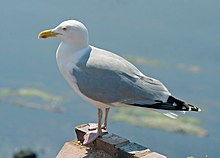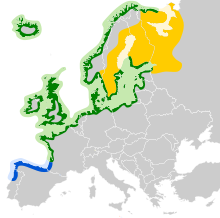European herring gull
| European herring gull | |
|---|---|
 |
|
| Breeding-plumaged adult on Heligoland | |
| Scientific classification | |
| Kingdom: | Animalia |
| Phylum: | Chordata |
| Class: | Aves |
| Order: | Charadriiformes |
| Family: | Laridae |
| Genus: | Larus |
| Species: | L. argentatus |
| Binomial name | |
|
Larus argentatus Pontoppidan, 1763, Denmark |
|
 |
|
| Range of L. argentatus Breeding range Year-round range Wintering range | |
The European herring gull (Larus argentatus) is a large gull (up to 26 in (66 cm) long). One of the best known of all gulls along the shores of western Europe, it was once abundant. It breeds across Northern Europe, Western Europe, Central Europe, Eastern Europe, Scandinavia and the Baltic states. Some European herring gulls, especially those resident in colder areas, migrate further south in winter, but many are permanent residents, e.g. in the British Isles, Iceland, or on the North Sea shores. European herring gulls have a varied diet, including fish, crustaceans and dead animals as well as some plants.
While herring gull numbers appear to have been harmed in recent years, possibly by fish population declines and competition, they have proved able to survive in human-adapted areas and can often be seen in towns acting as scavengers.
The scientific name is from Latin. Larus appears to have referred to a gull or other large seabird and argentatus means decorated with silver.
The taxonomy of the herring gull/lesser black-backed gull complex is very complicated, different authorities recognising between two and eight species.
This group has a ring distribution around the Northern Hemisphere. Differences between adjacent forms in this ring are fairly small, but by the time the circuit is completed, the end members, herring gull and lesser black-backed gull, are clearly different species. The terminal forms don't interbreed even though they coexist in the same localities.
The Association of European Rarities Committees recognises six species:
The two following taxa are classified as subspecies of Larus argentatus by some authorities such as the American Ornithologists' Union and Handbook of the Birds of the World. Others such as the Association of European Rarities Committees and British Ornithologists' Union now regard them as one or two separate species.
...
Wikipedia

